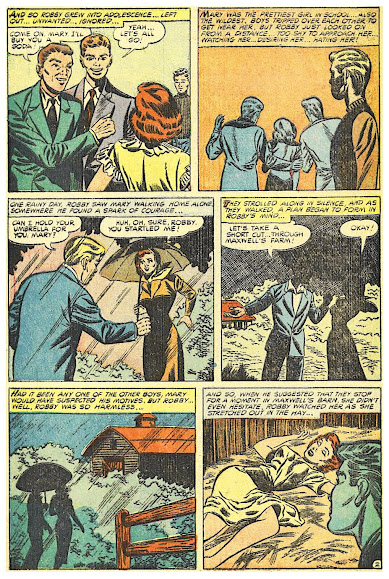Well, if you were paying attention in the intro of the previous post, then you probably saw this one coming next. Even more shocking than the story itself is that somehow, in all these years, I've never posted this original January 1954 issue of the Weird Mysteries #8 version until now (though I did post the very graphic Eerie Pub re-title / remake a few times in the THOIA Archive HERE, and we put it in Haunted Horror #22 too.) So how well does this story hold up today as a reflection of modern society ie: high schooler frustration levels, teen suicide, clueless parenting etc? Spot any Jack Davis swipes?







5 comments:
I wonder how much of an editorial or artistic decision that last page was? There's no good reason to shadow in some of the figures (other than the more gruesome stuff) so there was a reason (it wasn't environmental, the captions mention it's morning.) Just wondering where it came from.
The Eerie pub version dispenses with all that nonsense. No shadowing there! Heck, here's your close up of the hanging!
There's still a pretty 50s approach to women here -- the attempted rape is pretty much brushed away and there's a very, very modern "women want bad boys" vibe going on in the writing. It feels like the writer is trying to give it a slight sense of justification, to make the ironic ending hit a bit harder. There's a lot more to chew on in this story in relation to today than just the high school loner turned murderer.
I really like the repeat of the hanging in the last panel to really drive the point home.
Robby, the poor sap who couldn't do anything right. Robby was Ziggy or The Born Loser before either existed.
I’m hearing that some of you are having trouble leaving comments. Not sure what’s up, possibly another blogger update, but please hang in there.
I see I already gushed over the art in this one back in the day, so no need to cover the same territory. I do dearly love that last page with all its wood grain and stylin' high contrasts.
I think the story is really interesting, in that it intermingles--confuses?--notions of fame and infamy. It happens in the narration, so I think it's fair to say it isn't just the character who does this. It really feels prescient from the perspective of a modern world with headline-chasing shooters. It also feels a lot like nihilism when the pitch black punchline is that Mary died for nothing, especially since the "something" was just kind of criminal record. Normally I would ding this for not paying more attention to her, but actually that might have been unbearable. As it is, I'm already so impressed by her spunky freedom and her shamelessness that her fate rankles.
It reminds me a little of an ALFRED HITCHCOCK PRESENTS episode called "Fatal Figures," where John McGiver plays a "nobody" who commits crimes to make a mark, but only to be a "crime statistic," without his name being attached to them. Which is pictured as "having it both ways."
The other difference is that he "works his way up" to murder.
Post a Comment